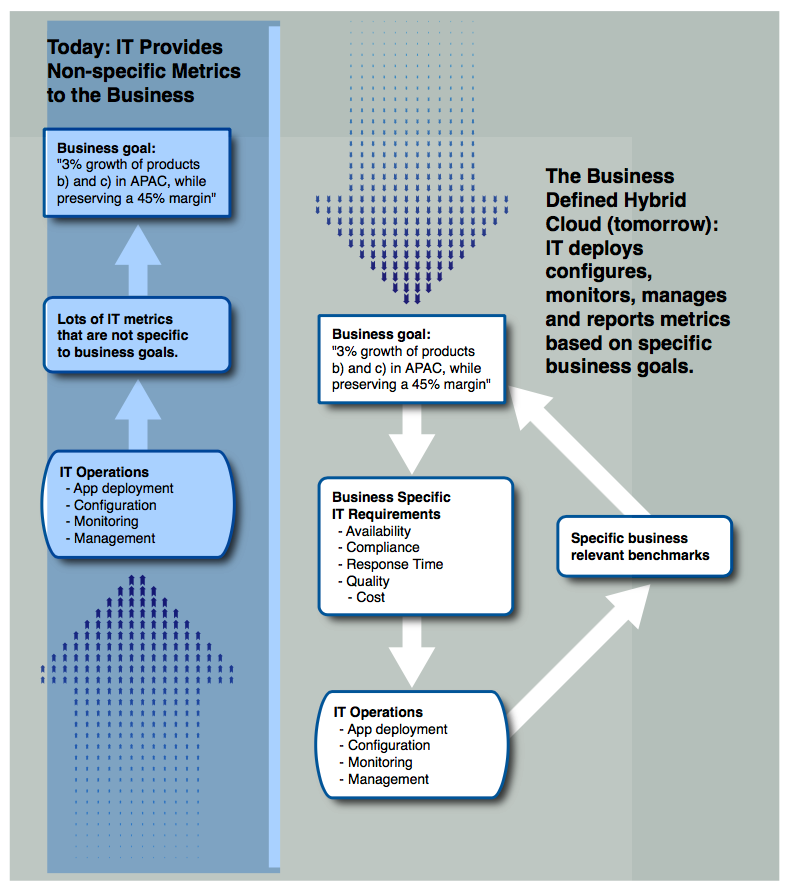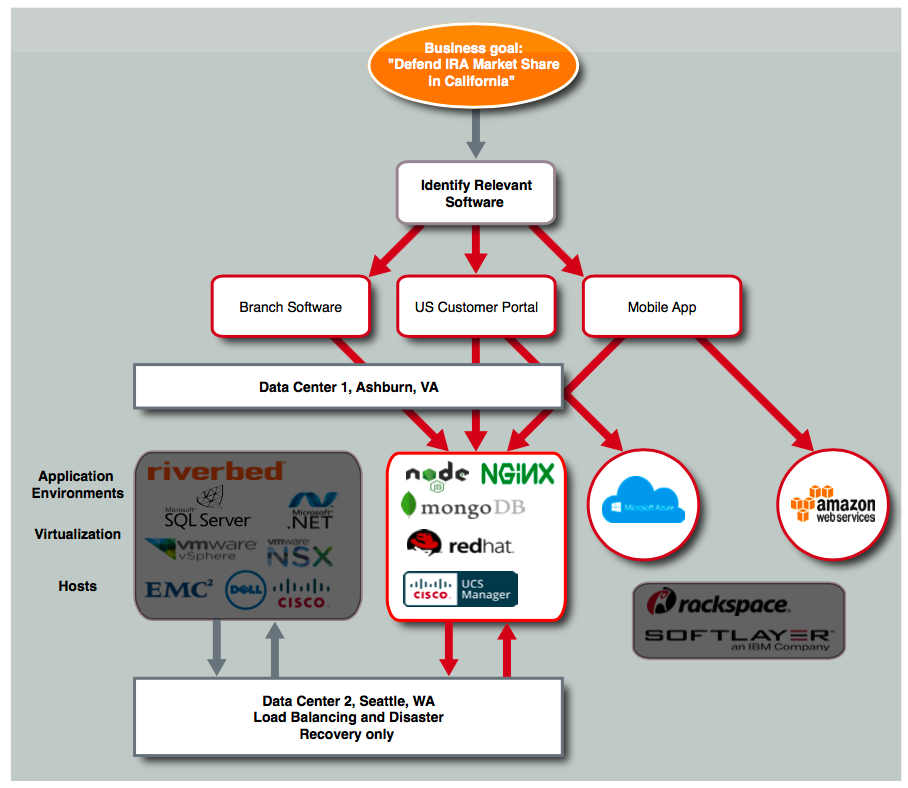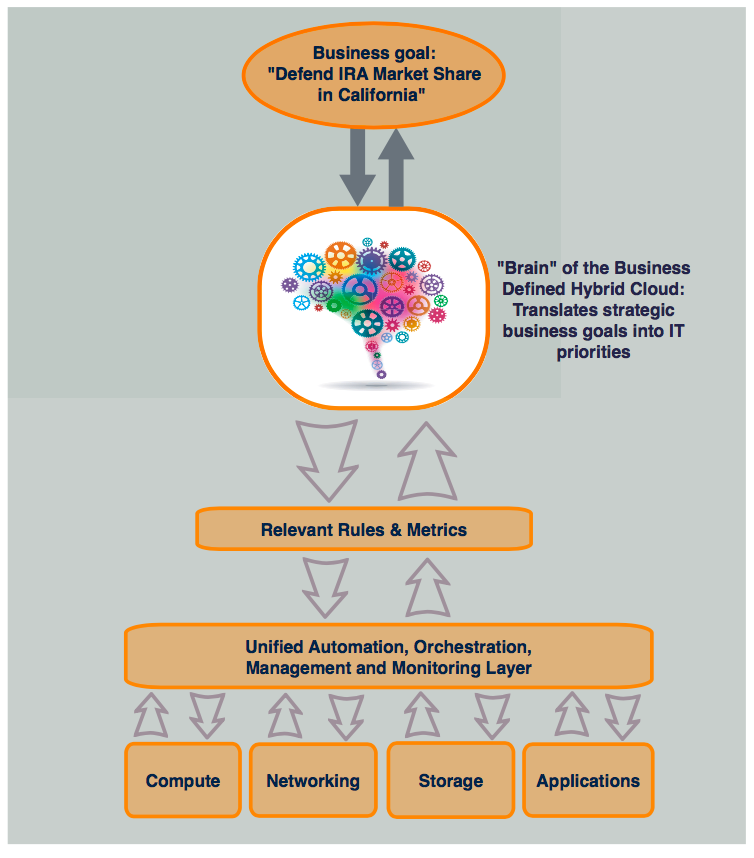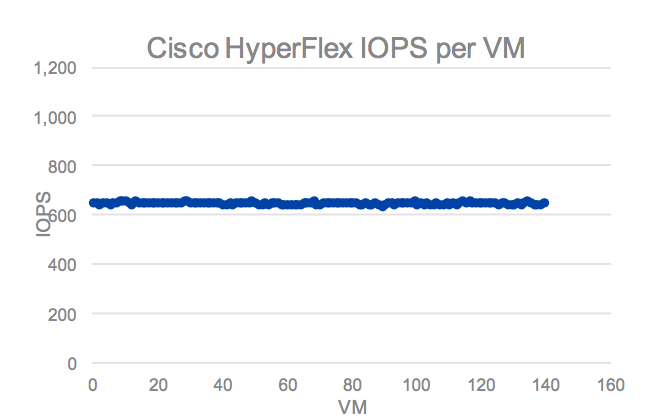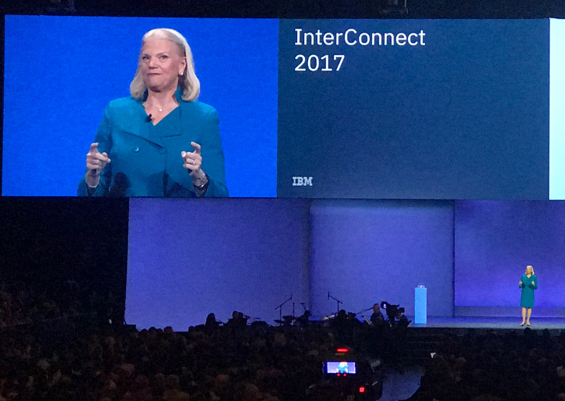Let us look at a hypothetical example to better understand the difference between the traditional bottom-up approach to hybrid cloud management and the new business-driven paradigm. In Q4 of 2016, a bank wants to gain a 3% market share in North America with its trading tools directed toward savvy end customers that are between 30 and 40 years old, have an average household income of over $100k, and live in California. After reaching the Q4 goal, this same bank sets itself the new objective of defending its IRA market share against aggressive competition in California.
Of course, our example bank does not want to sacrifice its hard-earned 3% gain in market share of affluent 30-40 year old hobby traders, but the stakes of the battle for the Californian IRA market are much higher. Additionally, those stakes are existential for the bank, which means that “defending California” justifies some sacrifices. To translate these two strategic goals into an actionable IT operations strategy, the IT department needs to know which business initiatives — marketing campaigns, price changes, acquisitions, opening of online store, etc. — are planned and how they map against the corporate hybrid IT infrastructure and applications.
First: Granular and Complete Knowledge of Business Strategy
IT has to know which applications have a direct or indirect impact on the bank’s ability to convince customers not change their IRAs over to the competition. This can reach from the software used by advisors in branches to optimally show the advantages of its IRAs, to the bank’s customer portal that offers an interactive investment dashboard with a sophisticated analytics-driven virtual advisor. Our bank’s marketing department also wants to run an extensive campaign that relies on a new mobile app offering real-time info on customers’ total portfolios, beyond just their IRAs. This app is also available to customers in the rest of the US (note the positive overall side effect on the corporate bottom line), however, the focus must be on Californian customers.
Of course, our bank’s California strategy must consider a myriad of additional IT-related factors that prevent customers from leaving, such as the quality of customer support and, even more difficult to address, the satisfaction of Californian IRA customers with the bank’s other financial products.
Once all of the applications supporting the above strategic initiatives are identified, IT needs to “draw lines” from the app level all the way down to the lowest IT infrastructure level: LUNs, network switches, servers, and power supplies. IT also needs to be aware of any relevant dependencies between other internal or external apps and services, and the apps that were deemed critical to the current business strategy. Our example bank is using the Amazon Relational Database Service that drives the new mobile app. The bank also leverages the Azure Machine Learning Service that powers its cutting-edge virtual investment advisor.
Second: Turn this Knowledge into IT Management Priorities
In the state of full transparency described above, the CTO will instruct all IT operations teams to “drop everything” the moment a yellow light comes on, which indicates looming trouble that could negatively affect any of the systems that drive the apps and services that were identified as the most strategically relevant for Q1. This affects all IT operations teams, including NOC, storage, systems administrators, web admins, DevOps, security, and so on. It could also affect release priorities of seemingly unrelated software (development tasks may need to be reprioritized), the timeline for a storage refresh (lower storage latency may reduce the time of our virtual investment advisor to respond to customer questions), or the adoption of new hyperconverged infrastructure. In our example, it would make sense to immediately order and deploy three of the five hyper-converged racks, as they help reduce the time it takes to connect a Californian customer to the help desk by an average of five minutes.
The New Paradigm is Business-centric and Consumption-based
Following this top-down business-driven approach means that IT operations have to start adopting a consumption-centric worldview, where infrastructure, platform, and software services must be optimized for consumption by line of business developers. The faster, simpler, and more flexible the “innards” of the data center are exposed to developers, the better these developers can compose new apps and services that set the organization apart from the competition. Amazon, with its extensive service offerings, has shown the incredible hunger of business units for easily consumable APIs. Business units now expect the same API quality from the corporate data center.
The New Paradigm is Dynamic and Infrastructure-agnostic
Business-centric and consumption-based IT management is only feasible if all layers of enterprise IT are “aware” of the relevance of applications and their underlying infrastructure for the individual business goals. This means that we need a “brain” that orchestrates, automates, monitors, and manages today’s hybrid IT environments based on constantly changing business goals.
Today, we are at the very beginning of this journey to the business-defined hybrid cloud, where changes in corporate strategy are translated into IT priorities and decisions in real time. Machine learning and artificial intelligence will need to take center stage to turn this vision into reality. In the next 2-3 years, we will see tremendous advancements toward developing business-aware infrastructure, applications, and services that can communicate with a central management layer that will dynamically orchestrate and Optimize hybrid IT operations, based on rapidly-changing business strategies and their corresponding initiatives.

